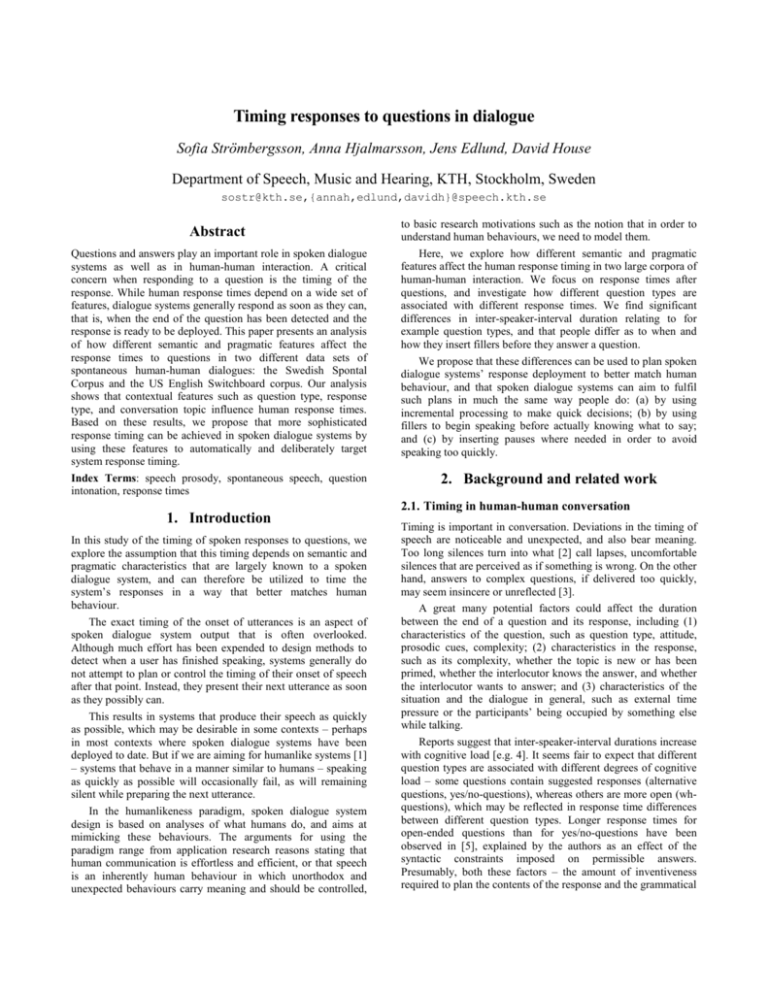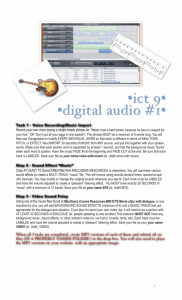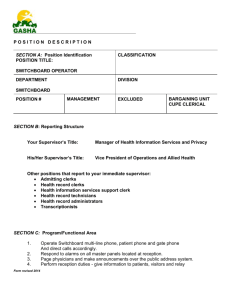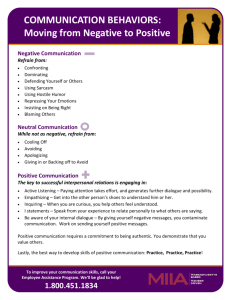Timing responses to questions in dialogue
advertisement

Timing responses to questions in dialogue
Sofia Strömbergsson, Anna Hjalmarsson, Jens Edlund, David House
Department of Speech, Music and Hearing, KTH, Stockholm, Sweden
sostr@kth.se,{annah,edlund,davidh}@speech.kth.se
Abstract
Questions and answers play an important role in spoken dialogue
systems as well as in human-human interaction. A critical
concern when responding to a question is the timing of the
response. While human response times depend on a wide set of
features, dialogue systems generally respond as soon as they can,
that is, when the end of the question has been detected and the
response is ready to be deployed. This paper presents an analysis
of how different semantic and pragmatic features affect the
response times to questions in two different data sets of
spontaneous human-human dialogues: the Swedish Spontal
Corpus and the US English Switchboard corpus. Our analysis
shows that contextual features such as question type, response
type, and conversation topic influence human response times.
Based on these results, we propose that more sophisticated
response timing can be achieved in spoken dialogue systems by
using these features to automatically and deliberately target
system response timing.
Index Terms: speech prosody, spontaneous speech, question
intonation, response times
1. Introduction
In this study of the timing of spoken responses to questions, we
explore the assumption that this timing depends on semantic and
pragmatic characteristics that are largely known to a spoken
dialogue system, and can therefore be utilized to time the
system’s responses in a way that better matches human
behaviour.
The exact timing of the onset of utterances is an aspect of
spoken dialogue system output that is often overlooked.
Although much effort has been expended to design methods to
detect when a user has finished speaking, systems generally do
not attempt to plan or control the timing of their onset of speech
after that point. Instead, they present their next utterance as soon
as they possibly can.
This results in systems that produce their speech as quickly
as possible, which may be desirable in some contexts – perhaps
in most contexts where spoken dialogue systems have been
deployed to date. But if we are aiming for humanlike systems [1]
– systems that behave in a manner similar to humans – speaking
as quickly as possible will occasionally fail, as will remaining
silent while preparing the next utterance.
In the humanlikeness paradigm, spoken dialogue system
design is based on analyses of what humans do, and aims at
mimicking these behaviours. The arguments for using the
paradigm range from application research reasons stating that
human communication is effortless and efficient, or that speech
is an inherently human behaviour in which unorthodox and
unexpected behaviours carry meaning and should be controlled,
to basic research motivations such as the notion that in order to
understand human behaviours, we need to model them.
Here, we explore how different semantic and pragmatic
features affect the human response timing in two large corpora of
human-human interaction. We focus on response times after
questions, and investigate how different question types are
associated with different response times. We find significant
differences in inter-speaker-interval duration relating to for
example question types, and that people differ as to when and
how they insert fillers before they answer a question.
We propose that these differences can be used to plan spoken
dialogue systems’ response deployment to better match human
behaviour, and that spoken dialogue systems can aim to fulfil
such plans in much the same way people do: (a) by using
incremental processing to make quick decisions; (b) by using
fillers to begin speaking before actually knowing what to say;
and (c) by inserting pauses where needed in order to avoid
speaking too quickly.
2. Background and related work
2.1. Timing in human-human conversation
Timing is important in conversation. Deviations in the timing of
speech are noticeable and unexpected, and also bear meaning.
Too long silences turn into what [2] call lapses, uncomfortable
silences that are perceived as if something is wrong. On the other
hand, answers to complex questions, if delivered too quickly,
may seem insincere or unreflected [3].
A great many potential factors could affect the duration
between the end of a question and its response, including (1)
characteristics of the question, such as question type, attitude,
prosodic cues, complexity; (2) characteristics in the response,
such as its complexity, whether the topic is new or has been
primed, whether the interlocutor knows the answer, and whether
the interlocutor wants to answer; and (3) characteristics of the
situation and the dialogue in general, such as external time
pressure or the participants’ being occupied by something else
while talking.
Reports suggest that inter-speaker-interval durations increase
with cognitive load [e.g. 4]. It seems fair to expect that different
question types are associated with different degrees of cognitive
load – some questions contain suggested responses (alternative
questions, yes/no-questions), whereas others are more open (whquestions), which may be reflected in response time differences
between different question types. Longer response times for
open-ended questions than for yes/no-questions have been
observed in [5], explained by the authors as an effect of the
syntactic constraints imposed on permissible answers.
Presumably, both these factors – the amount of inventiveness
required to plan the contents of the response and the grammatical
complexity required to fulfil the syntactic expectations –
contribute to variation in cognitive load, which in turn affects the
timing of the response.
The time between the end of a question and its response can
also be related to the effect the response evokes in the
interlocutor; unexpectedly long response latencies might indicate
potential upcoming trouble, e.g. disagreement or rejection [6,7].
Moreover, factors like self-presentation have also been found to
play a role, e.g. embarrassing questions evoke longer gaps [8].
To compensate for response delays or to signal the intention
to respond although the response is not yet ready for deliverance,
speakers use fillers [9,10].
The conversational setting also influences speakers’ response
times; longer gaps have been observed in face-to-face
conversations compared to dialogues without eye-contact
[11,12], although the opposite have also been reported [13]. Only
minor differences have been observed across languages [14].
2.2. Timing in spoken dialogue systems
In human-machine interaction, the realization as well as the
processing of speech has traditionally been done in a strictly
turn-based manner. Such systems begin processing a user
utterance only when the user has stopped speaking, and the
planning of a new utterance does not commence until the user
utterance is fully analysed. The timing of the system’s response
depends on a silence threshold for end-of-utterance detection and
on the time it takes the system to generate a response.
Only recently have systems begun processing speech
incrementally [15,16,17], allowing them to significantly reduce
response times, since the decision about what to say can be made
incrementally, also during the user’s speech. Still, when the
system takes the decision to speak, it speaks as soon as it can.
Efforts to develop sophisticated turn-taking strategies for
spoken dialogue systems have aimed at reducing response times
while at the same time avoiding interrupting the user [e.g. 18;
19], but beyond faster-is-better, they have no awareness of their
exact timing, and make no attempt to control or modify it.
Exceptions include [20] and [21], both of which study the
possibility of allowing the system to produce overlapping
speech. [20] look at utterance completion and [21] at soft
overlaps. [22] tested a Wizard-of-Oz system that used one of the
strategies suggested here – to initiate a response early with the
help of a filler if response generation is too slow.
3. Method
3.1. Speech data
Two different sources of speech material were used – one
representing Swedish face-to-face conversation and one
representing US English telephone conversation. From these
datasets, turn-final questions were subject to analysis.
3.1.1. Spontal
For Swedish, the analyses were based on data retrieved from the
Spontal corpus [23], which contains orthographically transcribed
recordings of free dialogues between native speakers of Swedish,
situated face-to-face in the same room. A set of 600 Spontal
questions has been annotated with regards to question type,
previously described in [24]. This set of 600 questions is
balanced with regards to the interlocutors’ gender (same gender
or opposite gender) and previous acquaintance.
In the Spontal corpus, question type has been defined by
formal and functional characteristics in four independent
dimensions. The first dimension, Q1, has to do with question
type: if the question is best described as a yes/no-question (Y/N),
a wh-question (WH), a question including a restricted set of
alternative answers (ALT), or other (OTHER). Q2 concerns
whether a response was required (REQUIRED), possible
(OPTIONAL), or prohibited (PROHIBITED). Q3 can take one of
the values FORWARD or BACKWARD, where FORWARD applies
to questions where the speaker is asking for something that has
not already been said, whereas questions of the type BACKWARD
instead (only) refers to something that has already been stated.
Q4 concerns whether the question is a case of reported speech
(REPORTED), or not (DIRECT). For the purpose of this study,
questions labelled as REPORTED were excluded from analysis, as
responses to such questions are expected to behave differently
than responses to DIRECT questions. Moreover, questions
labelled as OTHER in Q1 were also excluded from this analysis,
as the size of the set OTHER was small (N = 24) and covered a
variety of question types not fitting into the main categories.
Table 1. Labels and descriptions of the analysed main
question types, in the Spontal and Switchboard datasets.
Spontal (N)
Wh (145)
Y/N (231)
Alt’s (21)
-
Switchboard (N)
qw (1248)
qy (3019)
qr (215)
qo (386)
bh (731)
Description
Wh-question
Yes/no-question
Alternative question
Open questions
Backchannel
3.1.2. Switchboard
The US English question data was extracted from the
Switchboard corpus [25]. The question types analysed in this
corpus were a subset of the questions annotated in the discourse
function annotation SWBD-DAMSL [26]. The question types
explored were the five most frequently occurring question
categories, namely qy, qw, bh, qo and qr (for descriptions, see
Table 1). Rhetorical questions were excluded from analysis.
3.2. Extraction of responses
For each question (Q) posed by one speaker, a potential response
(R) from the interlocutor was extracted automatically such that,
a) R is the first speech activity in the opposite channel after the
start of Q, and b) R does not end before Q, and c) R does not
contain only non-speech (laughter, coughing etc.).
3.3. Response-initial fillers
For each of the two datasets, a set of fillers was defined. The
selection of fillers was restricted to tokens that were considered
unambiguous with regards to their function. For example, tokens
like “yeah” and “uh-hu”, which have been considered as fillers in
some contexts [27] were not included, as these tokens often act
as positive responses in this context. For the Switchboard
dataset, the list of fillers consisted of the tokens “uh”, “um” and
“well”, and for the Spontal dataset, the corresponding list
contained the tokens “eh” and “ehm”.
3.4. Response types and conversation topic
In the Switchboard corpus we also extracted two additional
features, the discourse function of the response and the
conversation topic, as both of these features were hypothesized
to affect response time. The discourse function of the response
was extracted from the SWBD-DAMSL annotation based on the
discourse function of the response as defined in 3.2. The
conversation topic was the topic given to the speakers
beforehand and which they were to converse generally about.
4. Results
Figure 1 displays the overall distributions of response times in
the Switchboard and Spontal datasets. The subsequent
presentation of the analysis of response times is divided into
sections based on whether we explore features within the
question, features related to the response, or other contextual
features.
700
OPEN
Frequency
600
Switchboard
500
WH
Y/N
400
BC
300
ALT'S
200
0
100
0
100
200
300
400
500
Figure 2. Response times (msecs) across question types
in the Switchboard dataset. Error bars represent 1 S.E.
Time from end of question (msec)
Frequency
significant differences in response time across question type
(F(4, 5594) = 34.98, p < .001) following the pattern illustrated in
Figure 2. Bonferroni post-hoc analysis showed significant
differences in response time between OPEN questions and all
other types of questions, and between WH questions and all other
types of questions.
For the Spontal questions, the differences in response time is
not significantly dependent on question type (F(2, 382) = 1.71,
p = .183) although the same trend is observed; average response
time after WH questions (M = 139 ms, SD = 852) is longer than
that after Y/N questions (M = 13 ms, SD = 836) and ALT’S
questions (M = -186 ms, SD = 1227).
As indicated in Figure 1, average response time across all
question types is generally longer in the Switchboard data
(M = 216 ms, SD = 573), than in the Spontal data (M = 47,
SD = 868). This difference is significant: F(1, 5234) = 28.30,
p < .001.
45
40
35
30
25
20
15
10
5
0
Spontal
Time from end of question (msec)
For the Spontal data, where question type annotation was
available also for degree of response elicitation (Q2) and for
whether the question requested new information or not (Q3),
response time patterns were also investigated with regards to
these dimensions. For Q2, this analysis showed no significant
differences in response time dependent on the degree of response
elicitation (F(2, 382) = 1.88, p = .16), despite a trend that
questions to which answers are REQUIRED are associated with
longer response times (M = 79 ms, SD = 857) compared to
questions to which answers are OPTIONAL (M = -175 ms,
SD = 936). For Q3, however, the difference in response time
between BACKWARD and FORWARD question is significant (F(1,
383) = 5.98, p = .02) such that responses to BACKWARD directed
questions come significantly earlier (M = -222 ms, SD = 736)
than responses to FORWARD directed questions (M = 90 ms, SD
= 881).
4.2. Response features
Figure 1. Response time distribution in the Switchboard
(upper panel) and Spontal (lower panel) datasets.
4.1. Question features
4.1.1. Variation related to question type
For each of the two datasets, a one-way ANOVA was used to
explore the variation in response time across the different
question types. For the Switchboard dataset, this revealed
4.2.1. Response types
A one-way ANOVA showed that variation in response time
could be linked to response type (F(43, 5555) = 3.28, p < .001).
Figure 3 displays the 10 most frequent response types in the
Switchboard dataset, and how they are distributed in relation to
response time.
between speakers, and between dialogues. Table 2 shows the
ANOVA statistic for these analyses.
Table 2. ANOVA statistics for response time variation
across speakers and across dialogues within the
Switchboard and Spontal datasets.
other
dispreferred
negative non-no answers
statement-opinion
no answers
F
p
Dialog -> Response time
Switchboard
Spontal
1.58
2.84
< .001
< .001
Speaker -> Response time
Switchboard
Spontal
1.45
2.76
< .001
< .001
yes-no-question
statement non-opinion
abandoned
affirmative non-yes
5. Discussion
yes answers
0
100
200
300
400
500
Figure 3. Response times (in milliseconds) across
response types in the Switchboard (SWBD) dataset.
Error bars represent 1 S.E.
4.2.2. Response-initial fillers
A one-way ANOVA revealed that the distribution of filler-initial
responses was significantly related to response time (F(1,
4849) = 150.23, p < .001) such that responses starting with fillers
come significantly later (M = 385 ms, SD = 515) than responses
starting with other tokens (M = 158 ms, SD = 581). For the
Spontal dataset, however, no such dependence was found, F(1,
383) = .01, p = .94.
Exploration of the distribution of response-initial fillers
across the different question types reveals a significant
interdependence, χ2(4, N = 5599) = 709.59, p < .001. Here, the
proportion of responses to OPEN questions (62%) and WH
questions (43%) that start with fillers is considerably larger than
within responses to either Y/N questions (19%) or ALT’S
questions (28%). For the Spontal dataset, the dependence is not
significant, χ2(2, N = 385) = 4.11, p = .13, although the
distribution follows the same pattern: the proportion of responses
to WH questions that start with fillers is larger than that of
responses to either Y/N questions or ALT’S questions.
For the Spontal questions, the distribution of response-initial
fillers was also analysed with regards to Q2 and Q3. For Q2,
responses to questions to which answers are OPTIONAL never
start with a filler, whereas the proportion of responses starting
with a filler among responses to questions REQUIRING an answer
is 16%; this interdependence is significant (χ2(2,
N = 385) = 9.39, p = .01). Regarding Q3, the proportion of
FORWARD directed questions starting with a filler (15%) is larger
than among responses to BACKWARD directed questions (6%),
although this dependence only approaches significance (χ2(1,
N = 385) = 3.40, p = .06).
4.3. Contextual features
An analysis of whether response time varied across different
topics revealed a significant dependence, F(47, 5551) = 1.76,
p = .001. In both datasets, variation in response time also varied
In this study, we explored response times to questions in two
corpora of human-human dialogue data. The results show a
number of significant relationships between different semantic
and pragmatic factors and response time. For example it was
found that wh-questions and open questions have significantly
longer response times than y/n and alternative questions in the
Switchboard corpus. Thus, it takes longer to respond to a
question when the response alternatives are not provided in the
question. Furthermore, analyses of the relationship between
response type and timing reveal that positive responses come
earlier than negative answers.
Although the trends were similar in both datasets, we did not
find the significant difference in response times between the
question types in the Spontal dataset that we found in the
Switchboard material. Differences between the datasets could be
due to the different settings – face-to-face conversation vs.
telephone calls – or an artefact of the size difference between the
datasets (Spontal n=600 and Switchboard n=5599). However,
both datasets are cooperative conversations and these are known
to have longer gaps than in competitive conversations [28].
6. Conclusion
We propose that humanlike dialogue systems should aim to
adjust their response times based on the contextual factors
presented above in order to better match human response times.
This is further motivated by the fact that deviations in response
times may actually bear meaning that can affect the users’
perception of the response. Many current systems already have
the technical means necessary to achieve precision timing by
either holding their response or inserting fillers in cases where
response generation is too slow. The latter technique, in
particular, is often used by people, and may well act in itself to
make systems more humanlike.
7. Acknowledgements
The work presented here is funded by the Swedish Research
Council projects (VR 2009-1764) Intonational variation in
questions in Swedish and (VR 2011-6152) Classifying and
deploying pauses for flow control in conversational systems and
the GetHomeSafe project (EU 7th Framework STREP 288667).
8. References
[1] Edlund, J., Gustafson, J., Heldner, M., & Hjalmarsson, A.
(2008). Towards human-like spoken dialogue systems.
Speech Communication, 50(8-9), 630-645.
[2] Sacks, H., Schegloff, E., & Jefferson, G. (1974). A simplest
systematics for the organization of turn-taking for
conversation. Language, 50, 696-735.
[3] Heldner, M., & Edlund, J. (2010). Pauses, gaps and
overlaps in conversations. Journal of Phonetics, 38, 555568.
[4] Cappella, J. N. (1979). Talk-silence sequences in informal
conversations I. Human Communication Research, 6(1), 317.
[5] Walczyk, J. J., Roper, K. S., Seemann, E., & M. Humphrey,
A. (2003). Cognitive mechanisms underlying lying to
questions: Response time as a cue to deception. Applied
Cognitive Psychology, 17, 755-774.
[6] Gardner, R., Fitzgerald, R., & Mushin, I. (2009). The
underlying orderliness in turn-taking: Examples. Australian
Journal of Communication, 36(3), 65-90.
[7] Schegloff, E. A. (2007). Sequence organization in
interaction, volume 1: a primer in conversation analysis.
Cambridge University Press.
[8] DePaulo, B. M., Kashy, D., Kirkendol, S., Wyer, M., &
Epstein, J. (1996). Lying in everyday life. Journal of
Personality and Social Psychology, 70(5), 979-995.
[9] Smith, V. L., & Clark, H. H. (1993). On the course of
answering questions. Journal of Memory and Language,
32(1), 25-38.
[10] Clark, H. H., & Fox Tree, J. E. (2002). Using uh and um in
spontaneous speaking. Cognition, 84(1), 73-111.
[11] Jaffe, J., & Feldstein, S. (1970). Rhythms of dialogue. New
York: Academic Press.
[12] ten Bosch, L., Oostdijk, N., & de Ruiter, J. P. (2004). Turntaking in social talk dialogues: temporal, formal and
functional aspects. In SPECOM’2004: 9th Conference
Speech and Computer. St. Petersburg, Russia.
[13] Sellen, A. (1995). Remote conversations: The effects of
mediating talk with technology. Human-Computer
Interaction, 10(4), 401-444.
[14] Weilhammer, K., & Rabold, S. (2003). Durational aspects
in turn taking. In ICPhS 2003. Barcelona, Spain.
[15] Schlangen, D., & Skantze, G. (2011). A General, Abstract
Model of Incremental Dialogue Processing. Dialogue &
Discourse, 2(1), 83-111.
[16] Buss, O., & Schlangen, D. (2010). Modelling SubUtterance Phenomena in Spoken Dialogue Systems. In
Proceedings of Semdial 2010 (Pozdial) (pp. 33-41). Poznan,
Poland.
[17] Baumann, T., Atterer, M., & Schlangen, D. (2009).
Assessing and Improving the Performance of Speech
Recognition for Incremental Systems. In Proceedings of
NAACL-HLT. Boulder, Colorado, USA.
[18] Raux, A. (2008). Flexible Turn-Taking for Spoken Dialog
Systems. Doctoral dissertation, School of Computer Science
Carnegie Mellon University.
[19] Dethlefs, N., Hastie, H., Rieser, V., & Lemon, O. (2012).
Optimising Incremental Dialogue Decisions Using
Information Density for Interactive Systems. In Proceedings
of the Conference on Empirical Methods in Natural
[20]
[21]
[22]
[23]
[24]
[25]
[26]
[27]
[28]
Language Processing (EMNLP) (pp. 82-93). Jeju, South
Korea.
DeVault, D., Sagae, K., & Traum, D. (2009). Can I Finish?
Learning When to Respond to Incremental Interpretation
Results in Interactive Dialogue. In Proceedings of SigDial
(pp. 11-20). London, UK.
Edlund, J., & Hjalmarsson, A. (2012). Is it really worth it?
Cost-based selection of system responses to speech-inoverlap. In Proc. of the IVA 2012 workshop on Realtime
Conversational Virtual Agents (RCVA 2012). Santa Crux,
CA, USA.
Skantze, G., & Hjalmarsson, A. (2012). Towards
Incremental Speech Generation in Conversational Systems.
Computer Speech & Language, 27(1), 243-262.
Edlund, J., Beskow, J., Elenius, K., Hellmer, K.,
Strömbergsson, S., & House, D. (2010). Spontal: a Swedish
spontaneous dialogue corpus of audio, video and motion
capture. In Calzolari, N., Choukri, K., Maegaard, B.,
Mariani, J., Odjik, J., Piperidis, S., Rosner, M., & Tapias,
D. (Eds.), Proc. of the Seventh conference on International
Language Resources and Evaluation (LREC'10) (pp. 2992 2995). Valetta, Malta.
Strömbergsson, S., Edlund, J., & House, D. (2012).
Prosodic measurements and question types in the Spontal
corpus of Swedish dialogues. In Proc. of Interspeech 2012
(pp. 839-842). Portland, Oregon, US.
Godfrey, J. J., Holliman, E. C., & McDaniel, J. (1992).
SWITCHBOARD: Telephone speech corpus for research
and development. In IEEE International Conference on
Acoustics, Speech and Signal Processing (ICASSP) (pp.
517–520). San Francisco.
Jurafsky, D., Shriberg, E., & Biasca, D. (1997).
Switchboard SWBD-DAMSL annotation coders manual,
draft 13. Technical Report.
Ward, N., Vega, A., & Baumann, T. (2012). Prosodic and
temporal features for language modeling for dialog. Speech
Communication, 54(2), 161-174.
Trimboli, C., & Walker, M. B. (1984). Switching pauses in
cooperative and competitive conversations. Journal of
Experimental Social Psychology, 20(4), 297-311.









